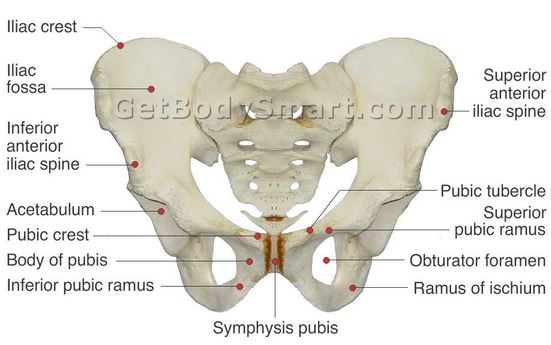Anterior Superior Iliac Spine
The ilium is the largest bone of the 3 bones that make up the outer section of the pelvis. There are projections in this bone that serve as landmarks for the identification of other clinical landmarks in the body [1, 2].
Anterior Superior Iliac Spine Clinical Anatomy
The anterior superior iliac spine (ASIS) is the most anterior part of the iliac crest. This part is the most observable and palpable of the pelvis. It can be palpated by putting the hands at the top of the hipbones and following the bony margins toward the front of the hips.

Location of Iliac Crest
Source -healthfixit.com
The ASIS will be the protrusion before the ilium starts to curve downward. This distance between the left and right ASIS is found to be greater in women compared to men because of the greater width of their pelvis.[1, 2, 3]

Figure 1 shows a diagram of the ASIS
Source – Getbodysmart.com
The ASIS has serve as a reference point to locate several other anatomical landmarks [3]:
McBurney’s point
This point pertains to the location of the base of the appendix. It is found one-third of the distance between the umbilicus and the right ASIS. Tenderness at this point is called the McBurney’s sign and is a reliable sign in the diagnosis of appendicitis [3, 4].
Roser-Nelaton line
This is a line drawn from the ASIS to the ischial tuberosity. The greater trochanter is normally located in this line, but in the event of a hip or femur fracture, it will be felt above this line [5].

True leg length
This measurement is taken from ASIS to the medial malleolus of the ankle joint. Differences in this measurement can be seen in different disorders of the hip area [2].
Attachments
Muscles
There are 2 thigh muscles that originate from the ASIS: the tensor fasciae latae (TFL) and the sartorius muscle. The TFL starts from the ASIS and runs down the anterolateral thigh while the sartorius muscle crosses the frontal thigh. These muscles make the forward and sideways movement of the leg and rotation of the hips possible [3].
Ligaments
The inguinal ligament is a band of connective tissues attaches from the ASIS. This long ligament that obliquely extends to the pubic tubercle. The said ligament serve as a demarcation line for the leg and the pelvis. It also keep the nerves, blood vessels and muscles of the pelvis and the leg are held in place [3].
Injuries
ASIS Avulsion Fracture
The ASIS may suffer from an avulsion fracture as a result of sudden or forceful contractions of the ASIS muscle and indirect trauma to the area. This type of injury is common in young athletes who will often report a popping or snapping sound at the time of the injury. They would complain of weakness in the area and this can be mistaken for an acute muscle strain. Mild types of ASIS avulsion fracture may cause some weakness to the flexion of the knee and extension to the knee while a severe fracture injury may lead to a limp on the affected side [6, 7, 8].

Treatment for this type of injury usually involves relief of symptoms with pain medications and activity modification to minimize weight bearing. Crutches are given to help patients through the recovery phase. It would take around 4-6 weeks for the fracture to spontaneously heal. If the ASIS had been displaced for more than 3 cm, there may be a need for a surgical intervention. An open reduction internal fixation of the ASIS in order to resolve the injury [6, 7, 8].
References
- Healthline Medical Team. (2015, March 12). Ilium. Retrieved from Healthline: http://www.healthline.com/human-body-maps/ilium-bone
- Teach Me Anatomy. (2015). The Hip Bone. Retrieved from Teach Me Anatomy: http://teachmeanatomy.info/pelvis/bones/the-hip-bone/
- Wise Geek. (2015). What is the Anterior Superior Iliac Spine? Retrieved from Wise Geek: http://www.wisegeek.com/what-is-the-anterior-superior-iliac-spine.htm
- Knipe, H., & Regmi, S. (2015). McBurney’s point. Retrieved from Radiopaedia: http://radiopaedia.org/articles/mcburneys-point-2
- Mondo Facto. (2000, March 5). Roser-Nelaton line. Retrieved from Mondo Facto: http://www.mondofacto.com/facts/dictionary?Roser-Nelaton+line
- Hacking, C. (2015). Anterior superior iliac spine avulsion injury. Retrieved from Radiopaedia: http://radiopaedia.org/articles/anterior-superior-iliac-spine-avulsion-injury
- Souder, C. (2015, May 3). Anterior Superior Iliac Spine (ASIS) Avulsion. Retrieved from Ortho Bullets: http://www.orthobullets.com/sports/3091/anterior-superior-iliac-spine-asis-avulsion
- Dhinsa, B. S., Jalgaonkar, A., Mann, B., Butt, S., & Pollock, R. (2011). Avulsion fracture of the anterior superior iliac spine: misdiagnosis of a bone tumour. Journal of Orthopaedics and Traumatology, 173-176.
